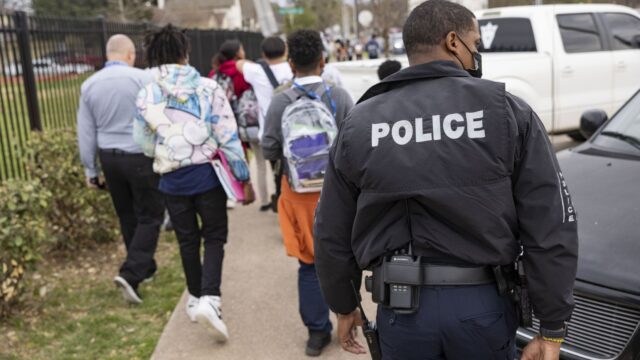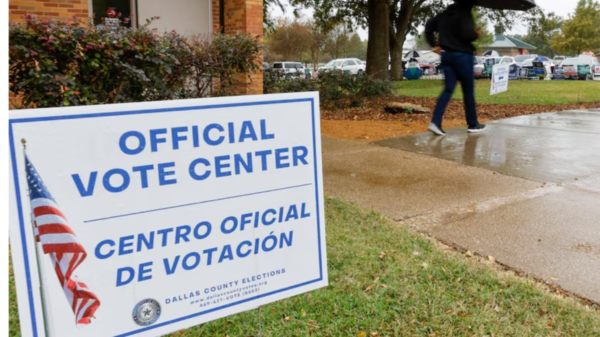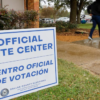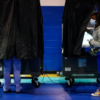By Emily Donaldson, Corbett Smith and Talia Richman

Even as Republican state leaders stressed “hardening” schools and increasing security measures as a response to the state’s deadliest shooting last week in Uvalde, educators stressed the community aspect to their campuses.
They are gathering places where families celebrate their students’ awards each quarter, watch children pack the auditorium at choir concerts and fill the hallways for meet-the-teacher nights.
Voters trickle into gymnasiums on Election Day to cast their ballots, and families in need can bring home meals from school-based food pantries.
“We live in a free and open society, and we want to value and cherish that,” said Ferris superintendent James Hartman. “I don’t think anyone in public education wants to create a ‘Fort Knox’ of schools. It’s just not realistic, and just doesn’t fit in what we want American society to be.”
Similar security-focused rhetoric arose after the deadly Santa Fe High School shooting in 2018 but the state still provides little money for such improvements. Local taxpayers shoulder the bulk of the financial burden through bonds, which the state has made more challenging to pass in recent years.
But school superintendents say costs and logistics — such as aging campuses, the sprawling footprint of buildings and sheer number of students flowing through — make hardening a challenging solution to implement.
Texas schools encompass more than 8,000 campuses and 672 million square feet, larger than every other state’s footprint than California, according to the National Council on School Facilities. Building designs and ages vary greatly, as do security protocols.
“A lot of our high school campuses across the state look like community college campuses with multiple buildings and different points of entry,” Terrell Superintendent Georgeanne Warnock said.
Republican leaders did not address these challenges when pushing for security updates.
This week, Gov. Greg Abbott directed the state education agency to develop more secure building standards for existing campuses built before 2021 and tasked the Texas Education Agency with encouraging administrators to increase the number of armed educators on campus.
Sen. Ted Cruz suggested on Fox News that schools should have “one door into and out of the school, and have that one door, armed police officers at that door.”
Lt. Gov. Dan Patrick joined in, too, telling Tucker Carlson, “we have to harden these targets so no one an get in, ever, except through one entrance.” He made similar comments four years ago after Santa Fe.
Research shows minimal evidence that school hardening measures are effective at preventing gun violence.
Visible security measures are “an attempt to alleviate parental and student fears regarding school safety and to make the community aware that schools are doing something,” James H. Price and Jagdish Khubchandani wrote in a 2019 study of school gun violence prevention strategies. The study reviewed 18 years of related research.
Officials should not give into political pressures to “‘do something’ when that ‘something’ is likely to be ineffective and wasteful of limited school resources,” the researchers wrote.
“The adoption of ineffective measures to reduce school firearm violence may lull parents, school personnel, and students into thinking they no longer have to be concerned about their safety at school,” they wrote.
Beyond hardening
All the security measures won’t stop a well-intentioned child or teacher.
Warnock has seen it happen often despite the training: someone props a door open to help another person enter the building who has her hands full.
If campuses locked down all but one single entry point, such routine behavior could easily leave a school vulnerable, experts and administrators say.
“The human error there is going to be even greater than facilities needs,” Warnock said.
Still, hardening school entries is an area where Texas Republicans are doubling down after Uvalde.
Abbott sent a letter on Wednesday asking the director of the Texas School Safety Center to randomly test schools’ security by approaching doors.
“Your team should begin conducting in-person, unannounced, random intruder detection audits on school districts,” Abbott wrote to Kathy Martinez-Prather. “Staff should approach campuses to find weak points and how quickly they can penetrate buildings without being stopped.”
He also demanded school districts meet to review campus protocols this summer, as well as assess the state of their locks and visitor check-in procedures.
The focus on having a single door for students also raises concerns about fire safety.
While many schools are designed to guide visitors to a main entrance, more than one exit doorway is often required by the International Fire Code based on the number of people a building serves.
As for securing every door with a guard or officer, having armed security does not guarantee a mass shooting won’t take place.
During the 2018 shooting at Marjory Stoneman Douglas High School in Florida, an armed school resource officer never went inside the campus or attempted to engage the gunman during the attack.
Florida then passed a law requiring officers at every school, a costly maneuver that critics say coincided with a rise in youth arrests and student expulsions. Because of the new legislation, Florida schools employed more police officers than school nurses, social workers or school psychologists, according to the Florida chapter of the American Civil Liberties Union.
Meanwhile, schools are already struggling with staffing issues and may not be able to find enough officers to man each entrance and exit.
Physical challenges
Sunnyvale Superintendent Doug Williams recently visited a nearby district’s high school where his staff had to pass through three checkpoints on an expansive campus to access the library. The campus has benefited from upgrades from two different bonds in the last decade.
“If you’ve got a school that was built 40 or 50 years ago, then you don’t have those same barriers built in,” Williams said.
The physical layout and age of campuses make addressing safety a challenge, administrators say.
Following the deadly Columbine school shooting in 1999, Williams served as an assistant principal on a campus with about a dozen portable buildings. His job included overseeing security protocols.
As students began their passing periods, someone had to unlock them and let them into buildings. It became a major security concern as the points of entry and exit grew, Williams said.
“If you’ve got portable buildings and then the kids have to go into the main hallway, the logistics of having to keep those doors open or having someone there to let them in those areas, those create security risks as well,” Williams said.
After the Sandy Hook shooting, then-Dallas ISD police chief Craig Miller successfully lobbied his district to install peepholes in the doors of 1,200 portables, part of a $4.5 million security upgrade. Portable buildings, Miller said last week, are typically among the least secured locations on campus.
While modern schools often are designed with security in mind, older and portable buildings are much more challenging to “harden.”
The average age of schools in the country was 44 years old in 2012, according to the National Center for Education Statistics. And in many areas — including Dallas — they’re much older. As of 2018-19, more than 99 of DISD schools were over 60 years old.
In Uvalde, questions remain about how the shooter gained access to the campus through an unlocked door. Doors left ajar are a procedural concern, Williams stressed, but older buildings might also have doors with locks that don’t function perfectly.
Some politicians, including former President Donald Trump, have suggested schools install metal detectors and have students pass through them before class each day. Many questioned why such technology wasn’t used regularly following the October shooting at an Arlington high school that left several injured.
Drawing comparisons to airport security, Williams questioned how long this security procedure would take. Airplane passengers must arrive at least an hour before their plane boards to go through security, which is often staffed by several security officers at a variety of checkpoints.
If a school serving hundreds of students starts at 8:25 a.m. and most arrive 10 minutes prior, classes won’t begin on time, the superintendent said.
“It’ll take you all first period just to walk them through security … so we’ve never looked at that as a viable option,” Williams said. He noted that many of the guns involved in school shootings haven’t come onto campus through the front entrance.
The size of a campus and the number of students enrolled makes a big difference in how hard it is to secure, Warnock said.
While Terrell’s elementary and middle school campuses are limited to single entry points, the high school is complicated. Hardening the high school – which contains breezeways where hundreds of teenagers pass through between classes – would likely require a rebuild, which could cost about $200 million, Warnock said.
Single-point entry campuses are “already the overwhelming norm across the state,” wrote Monty Exter, a senior lobbyist for the Association of Texas Professional Educators, but retrofitting or possibly rebuilding schools that aren’t would be “very” expensive.
Putting a dollar figure to those repairs – which would certainly be in the billions – would require a survey of every school system in the state, Exter added.
The Texas Education Agency currently does not ask districts for much in the way of facilities information – such as the number of exterior doors or portables or whether a security vestibule is present.
Meager state money available
Schools in Ferris – 20 miles south of downtown Dallas – would have had access controls added to each door. The new system would integrate coded ID cards with video surveillance, allowing front office staff to buzz in teachers or staff at every door on the district’s five campuses.
But voters went against a $53 million bond package that included $1 million dedicated to security upgrades. So for now, that technology exists only in the front entry of those schools, while the doors to places like playgrounds and parking lots still require keys, which superintendent Hartman noted remains a risk.
“The true aim of that was to create additional security,” he said, “because when humans forget their keys, there’s that urge to prop open doors as opposed to going back and getting them.”
Districts often have to rely on bond money to make sweeping security changes because the state provides minimal financial support. State support comes through a one-time, $100 million grant program created by the Texas Legislature in 2019.
Meanwhile, a newly created per-student safety allotment funneled $50 million to Texas’ 1,200 districts and charters in the 2021-22 year.
From the post-Santa Fe grant fund, Terrell received about $76,000 from the state for “hardening,” Warnock said, an amount the superintendent described as a “drop in the bucket.”
Ferris received $43,834 in one-time grant funding, and roughly $25,000 from the annual safety allotment, which Hartman called “not enough to do anything.”
For larger scale efforts – like security systems or vestibules – districts like Ferris must pay for physical improvements or new construction largely by asking voters to pass a bond, potentially increasing property tax bills.
And school security improvements are not a one-time cost; ongoing maintenance needs means districts have to replace camera systems and update communication systems on a regular basis.
But new state-required ballot language makes districts’ ask more challenging as it mandates they tell taxpayers “THIS IS A PROPERTY TAX INCREASE” even when approving a bond would not up anyone’s tax bill.
Education advocates say that’s led to an increase in failed bond proposals. Since the start of 2021, 42% of 430 school bonds have failed across the state, according to data from the Texas Bond Review Board.
Ferris, which was asking voters for a 18 cent tax increase in their most recent bond effort, has seen five bond propositions fail in the past two years.
Hartman said that he’d love to see the Legislature step up financially; providing the money for school resource officers at each campus – something that Ferris already does through its existing funding – would be a good step, he said.
“They’ve got to put dollars where they put priorities,” Hartman said.
While Texas superintendents support more money toward making schools safer, many have stressed the need for a focused, well-rounded approach rather than reactive.
Warnock, for example, wants more resources for counseling and social work staff, social media monitoring and training for parents to identify troubling signs.
Williams wants a comprehensive look at improving school safety, emphasizing that nothing can be off the table.
“They’ve got to talk about the weapons themselves,” he said, noting concerns about the assault rifle used in the Uvalde tragedy. “You’ll get into the Second Amendment argument and all of that, but there’s a difference between Second Amendment rights and an 18-year-old being able to purchase an AR-15.”
The DMN Education Lab deepens the coverage and conversation about urgent education issues critical to the future of North Texas.
The DMN Education Lab is a community-funded journalism initiative, with support from The Beck Group, Bobby and Lottye Lyle, Communities Foundation of Texas, The Dallas Foundation, Dallas Regional Chamber, Deedie Rose, Garrett and Cecilia Boone, The Meadows Foundation, Solutions Journalism Network, Southern Methodist University, Todd A. Williams Family Foundation and the University of Texas at Dallas. The Dallas Morning News retains full editorial control of the Education Lab’s journalism.









You must be logged in to post a comment Login